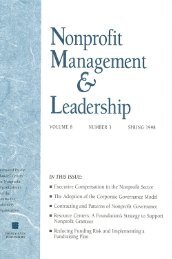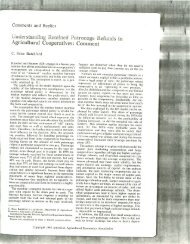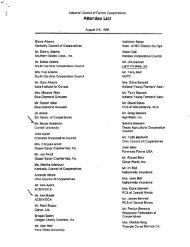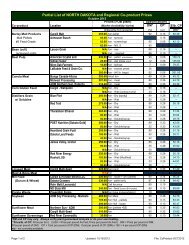Sunflower Production Field Guide - Your "Home Page"
Sunflower Production Field Guide - Your "Home Page"
Sunflower Production Field Guide - Your "Home Page"
Create successful ePaper yourself
Turn your PDF publications into a flip-book with our unique Google optimized e-Paper software.
40<br />
of the developing sunfl ower heads. Egg laying occurs<br />
from mid-July through August. The hatched larvae<br />
tunnel into the spongy tissue of the receptacle. Damage<br />
to the head is negligible. After 30 days, the mature<br />
larvae cut a small emergence hole on the underside of<br />
the receptacle and drop into the soil to pupate. Overwintering<br />
pupae are found about 7.5 inches (19 cm)<br />
deep in the soil by August or early September. Some<br />
larvae will pupate in the sunfl ower head. Only one<br />
generation per year occurs in North Dakota.<br />
Strauzia longipennis has one generation per year. This<br />
insect overwinters as a larva in plant debris in the<br />
soil. Pupation and adult emergence is completed in<br />
early June. Females lay eggs in stem tissue of young<br />
sunfl ower, and larvae feed in the pith tissue for much<br />
of the growing season.<br />
■ Figure 43. Adult - Sunfl ower seed<br />
maggot Neotephritis fi nalis. (Extension<br />
Entomology)<br />
■ Figure 44. Pupae - Sunfl ower seed maggot<br />
Neotephritis fi nalis. (Extension Entomology)<br />
Unlike the other two species of sunfl ower maggots,<br />
two complete generations per year of N. fi nalis occur<br />
in North Dakota. Adults of N. fi nalis emerge during<br />
the fi rst week of July. Egg deposition occurs on the corolla<br />
of incompletely opened sunfl ower infl orescences.<br />
The total larval period is 14 days. The fi rst generation<br />
of N. fi nalis pupates in the head; the second generation<br />
overwinters in the soil as pupae.<br />
Damage: Damage by sunfl ower maggots has been<br />
negligible.<br />
The maggots of Gymnocarena diffusa feed on the<br />
spongy receptacle tissue of the sunfl ower head and<br />
feeding may cause partially deformed heads. Larvae<br />
do not feed on developing seeds.<br />
The magnitude of damage to sunfl ower seeds by N.<br />
fi nalis larvae depends largely on the stage of larval<br />
and seed development. Seed sterility occurs when<br />
newly hatched larvae tunnel into the corolla of young<br />
blooms. Observations indicate that a single larva feeding<br />
on young fl owers will tunnel through 12 ovaries.<br />
Mature larvae feeding on older sunfl ower heads will<br />
destroy only one to three seeds.<br />
While infestation levels of S. longipennis occasionally<br />
have reached nearly 100 percent, damage from larval<br />
feeding is usually light. Part of a commercial sunfl<br />
ower fi eld next to a grassed waterway or other water<br />
source sometimes supports a higher than usual infestation.<br />
Under these conditions, high larval numbers of<br />
eight to 10 per stalk may be found and stalk breakage<br />
can occur. Stalk breakage of up to 30 percent of the<br />
plants has been recorded.<br />
Scouting Method: A scouting method has not been<br />
developed for sunfl ower maggots because of the negligible<br />
injury caused by these insects.<br />
Economic Threshold: None established.<br />
Management: Insecticide use has not been warranted<br />
for control of sunfl ower maggots.







